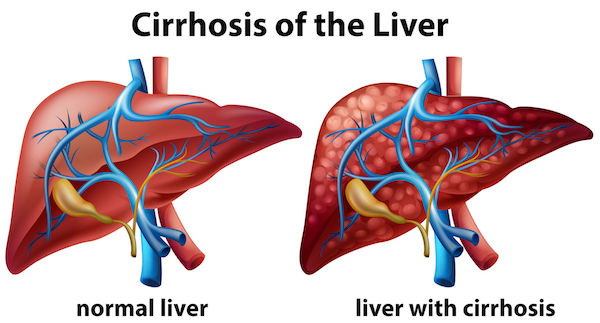Cirrhosis occurs when long-term damage to the liver leads to fibrosis (scarring), which makes it difficult for the liver, which plays an important role in detoxifying the body and the creation of key nutrients, to function as it should.

Globally, over half of all cirrhosis cases are attributable to hepatitis B or C, but there are many other possible cirrhosis causes, ranging from alcohol abuse, which accounts for 20 percent of cases, to fatty liver disease and other conditions that affect the liver. Female heavy drinkers are more at risk of developing cirrhosis than their male counterparts.
Ultimately, advanced cirrhosis can be fatal.
What are its symptoms?
Cirrhosis is a condition that develops gradually over time and as such may be asymptomatic until it is quite advanced and extensive damage has already occurred.
When they do begin to show, cirrhosis symptoms can include:
- Jaundice (characterised by yellowing of the skin and eyes and darkening of the urine)
- Bruising or bleeding easily due to the liver’s decreased ability to produce clotting factors
- Fatigue
- Loss of appetite
- Skin itching
- Swelling of the ankles, legs and abdomen
- Weakness
- Reddened palms
- Dark urine
- Difficulty concentrating or confusion, as the build-up of toxins in the blood begins to affect the brain
- Visible blood vessels under the skin, particularly on the abdomen
- Weight loss
How is it diagnosed?
A biopsy of the liver, in which a sample of the liver is examined under a microscope, is the gold standard test for a cirrhosis diagnosis, but usually this invasive and potentially risky procedure can be avoided if other tests point towards the condition.
These tests can include a physical examination to look for outward signs such as jaundice or to feel if the liver is enlarged and hardened, imaging tests such as ultrasound, CT scans or MRI scans that will show up any enlargement or hardening of the liver, and blood tests to measure liver function and clotting functions.
What are your treatment options?
There is no cure for cirrhosis. Cirrhosis treatment focuses on halting the progression of the disease and managing any complications that may arise as a result of the damage already done to the liver.
Stopping drinking is essential – if necessary, treatment for alcohol dependency needs to be sought. Medication to treat hepatitis can be used if this is the causative factor, while weight loss can be useful in cases caused by fatty liver disease.
In advanced cases where the liver can no longer do its job, a liver transplant is the only treatment option. Cirrhosis is the most common cause for liver transplant.
Can it be prevented?
Moderating alcohol intake is one of the most crucial steps everyone can take towards cirrhosis prevention.
The other important protective measure is preventing the spread of hepatitis B and C by practicing safe sex, not sharing needles and, for those at high risk, getting vaccinated against hepatitis B.
Studies also show that cirrhosis sufferers who are regular coffee drinkers have a decreased risk of dying from the disease than those who don’t drink coffee.
What to do now
Clicks Clinics offer hepatitis vaccines. Call 0860 254 257 to book an appointment or visit Clicks Clinics online.
IMAGE CREDIT: 123rf.com
